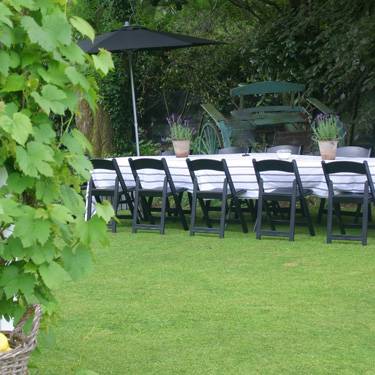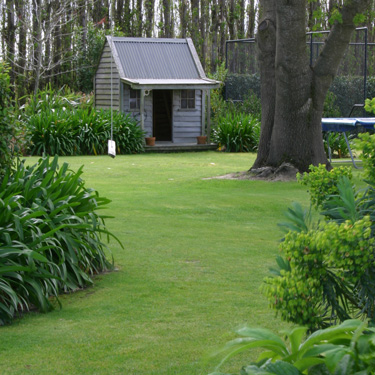Love your lawn this autumn
A lovely lawn gives a feeling of peace and comfort. Autumn is a great time to give your lawn the love it deserves, and the very best time to create a lovely new lawn - a soothing green space to come home to after a day’s work in the concrete jungle.
As long as it’s mown, the average kiwi lawn does a pretty good job of looking after itself. So much so that many of us consider it the low maintenance alternative to garden beds! But in a land not short on green open spaces we’re inclined to take our lawns for granted and overlook their full potential.
With a little extra pampering a lawn becomes more than an easy-care groundcover or practical play space. A lawn can be a thing of great beauty, adding a feeling of spaciousness and showing the garden to best advantage, even when the rest of it is off peak. On the other hand a weedy and parched lawn can drag the whole garden down with it.
A well-designed and maintained lawn adds much to the overall attractiveness of a garden, and the value of our property. According to research (Husqvarna report 2013), “In terms of garden elements that homeowners believe contribute most to property value, a well-maintained lawn tops the global list.”
Well designed
Apart from being lush, green and blemish free, a lawn looks best when it is a well defined shape with well defined edges. The shape of a lawn not only impacts on the look of the whole garden but also affects ease of maintenance. Generally, simple shapes work best in both instances.
Straight lines or generously sweeping curves (as opposed to wiggly snakes) are easy on the eye, easy to manoeuvre the mower around and make it easy to keep the edges nice and tidy.
While still allowing for the occasional ‘spilling over’ of plants, the line between garden and lawn should be clearly defined. And to save hours trimming and weeding, a solid mowing strip makes good sense. Even with a mowing strip the lawn’s edges take the most work to keep the garden looking tidy, so keep them as short and simple as possible.
Minimise the number of trees that need mowing around. Besides creating unnecessary work, a lawn dotted with trees and shrubs looks cluttered.
It’s worth asking yourself how much lawn you really need. Those who don’t enjoy mowing might say none. Families with children need lawns more than others. In many gardens there are shady or wet spaces where lawn fails to thrive or slopes that are too difficult to mow. Many other groundcover plants will create the look and feel of flat open space without resorting to hard surfaces.
It may be that downsizing your lawn to the sunniest, flattest, free- draining parts of your garden will leave you time to have it looking gorgeously green all year round. Small, purposeless areas that are fiddly to mow may be best given over to alternative ground treatments.
Autumn revamp
This side of summer, its common for lawns to look their worst, especially where there is drought and watering restrictions. But in a few simple steps you can have your lawn looking healthy and lush.
Feeding
Feed your lawn in autumn and spring to support the flush of growth. For a new lawn, apply a lawn fertiliser to the area and rake it into the top 2cm of soil just prior to sowing. Make sure you choose a product suitable for new lawns and apply it at the recommended rate. Too much can burn the young grass. After the first three or four cuts, make another light application. Some lawn seed comes with fertiliser added.
Nitrogen is what a lawn needs most to support lush green growth, but a good lawn fertiliser contains the correct proportions of nitrogen and other essential nutrients. Phosphorus is essential for healthy root growth, the foundation of your lawn. Most lawn fertilisers also contain a little iron sulphate to reduce moss, and potassium for disease resistance.
Watering
Lawns need regular rainfall or watering in order to stay green. If you have summer water restrictions, choose a drought tolerant lawn variety. A newly sown lawn must not be allowed to dry out. Water regularly using a fine mist spray - daily in the absence of rain or up to several times a day in hot or windy conditions. However, excessive watering can lead to the young grass seedlings dying through ‘damping off’ disease.
Over-seeding
Repairing and patching small areas of lawn by over-seeding is ideally done in autumn. First prepare the ground so that the seed can make good contact with the soil. Mow the lawn short then rake to remove thatch and create shallow grooves in the soil. Add a layer of weed-free topsoil or lawn mix, then scatter the seed and water gently. Feed and water as for a new lawn.
Weeds
Weeds love dry hungry lawns and can be kept to a minimum if you water feed and mow regularly. Small numbers of weeds can be dealt with by hand, otherwise special lawn weed sprays are available.
It’s a bad idea to spray new lawns with weedkiller for at least two months after sowing, but a selective herbicide prevents spring weeds and prickles getting hold before a young lawn is fully mature.
Moss turns up in shady, poorly drained or poorly fed lawns. Moss killers can be sprayed in spring or autumn but the moss will reappear if conditions remain the same.
Refilling
Sunken areas that have a good cover of turf may be remedied without sowing any seed: Cut and peel back a section of turf and fill underneath with topsoil or lawn mix. Carefully replace the turf and water thoroughly.
Aerating
To reduce compaction, improve water absorption and supply lawn roots with oxygen, use a garden fork to punch holes and aerate the soil. For very hard compact lawns, a ‘ core aerator’ machine may be needed.
A brand new lawn
There are two ways to create a new lawn; sow it from seed or roll out the green carpet of ready-made turf. Either way, ground preparation is key. First you need to get rid of all the old grasses and weeds (easiest by spraying the entire area with glysophate (e.g. Zero or Roundup). Then it’s time to cultivate, grade and level.
A load of weed free topsoil may be the best investment you ever make in your lawn. The last job before sowing or laying turf is to apply a suitable lawn fertiliser, spreading evenly at the recommended rate and raking it in to the top few centimetres of soil. Too much can burn!
Starting a new lawn from seed involves careful sowing, and then a few weeks of watering, waiting, and careful mowing. Autumn is the very best time as the ground is warm while the air is cool and moist.
For the impatient or time-poor gardener instant lawn may be the preferred option and considering the convenience and reliability, it’s cost effective too. Turf rolls should be laid with out delay. In hot weather, place them in the shade, sprinkle with water or cover with moist sacking. Lay the longest straight line first. For sloping areas, lay strips across the slope, starting at bottom and working uphill. Butt edges tightly, avoiding gaps or overlaps. Stagger joins in a brick-like fashion. Use a sharp knife to trim corners and ends. Use a board for kneeling and walking on laid turf. Water thoroughly within half an hour of completion.
Mowing tips
- For a thick weed free lawn, frequent light mowing (once a week to remove about a third of the growth) is best.
- Mower blades should remain raised while the weather is hot and dry. As autumn growth picks up they can be lowered.
- When growth slows down in winter, reduce mowing until spring growth kicks in.
- Make sure the mower blades are sharp.
- Don’t mow when the lawn is frosty or wet.
24-Feb-2015



